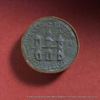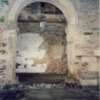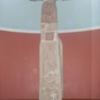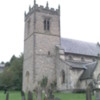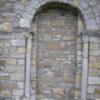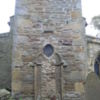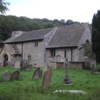Browse Items (91 total)
- Tags: Art history
Sort by:
The first seal of the Cathedral Chapter
The seal shows the front of a church. The earliest example of its use is on a document of 1133. At that date Exeter's Norman cathedral’s towers would not have been built, and the old Saxon cathedral was still standing.
The depiction could show…
The depiction could show…
Stained Glass in Anglo-Saxon England
From Videmus, the online magazine for medieval stained glass (http://www.vidimus.org/index.html): This feature supports the launch of a major campaign by the Wearmouth – Jarrow Partnership to have the remains of two Anglo-Saxon monasteries at…
Items about Two Saxon buildings at Deerhurst
There are two buildings at Deerhurst in Gloucestershire which are or contain Saxon remains.
Odda's chapel is shown first, then two features
from the nearby Church which was originally Saxon
and much developed later but retaining notable
Saxon…
Odda's chapel is shown first, then two features
from the nearby Church which was originally Saxon
and much developed later but retaining notable
Saxon…
Tags: Archaeology, Architecture, Art history, Building, Church, Deerhurst, Religion, Stonework
Photos of the Ruthwell Cross
Photos taken of the Ruthwell Cross at Ruthwell Church, Dumfriesshire, January 2010.
Tags: Art history, Cross, Religion, Runes, Ruthwell Cross, Stonework
Stonegrave Minster, North Yorkshire
Stonegrave Minster was in existence in AD 757 when a letter from Pope Paul was written to King Eadberht of Northumbria about appointing an abbot. The church was added onto during the Norman period, though most of the present church was built during…
Tags: Archaeology, Architecture, Art history, Building, Church, Religion, Stonework
All Saints' Church, Sinnington, North Yorkshire
The present church of All Saint's in Sinnington is mostly a late Norman building, but numerous fragments of Anglo-Saxon and Norse sculpture work are preserved in the fabric of the church, clearly implying that its origins are much earlier. I believe…
Tags: Archaeology, Architecture, Art history, Building, Church, Norman, Religion, Stonework
St Andrew's, Middleton, North Yorkshire
The church of St Andrew's at Middleton dates to the Anglo-Saxon period, and also preserves a considerable amount of Saxon architecture and Viking sculpturework. The bottom of the tower is part of the original Anglo-Saxon building, and the Saxon door…
Tags: Archaeology, Architecture, Art history, Building, Church, Cross, Religion, Stonework, Viking
St Hilda's Church, Ellerburn, North Yorkshire
St Hilda's Church is located in the village of Ellerburn in Rydale, North Yorkshire. The history of the church dates back to the Anglo-Saxon period. Built into the fabric of the present church are over thirteen early sculptural and architectural…
Tags: Archaeology, Architecture, Art history, Building, Church, Cross, Religion, Stonework
Alfred Jewel
The Alfred Jewel, possibly the handle of an aestel, is held in the Ashmolean Museum. Its motto reads (in modern English) "Alfred ordered me to be made". Discovered in the 17th century, it is believed to have been made in the 9th, probably in Wessex.
Tags: Alfred, Alfred Jewel, Archaeology, Art history, Ashmolean Museum
The Colouring of the Ruthwell and Bewcastle Crosses
These notes describe a project carried out at the Manchester Museum in the University of Manchester as part of the redisplay of the museum galleries in 1999-2000, to recolour a set of casts of the crosses at Bewcastle and Ruthwell churches acquired…

